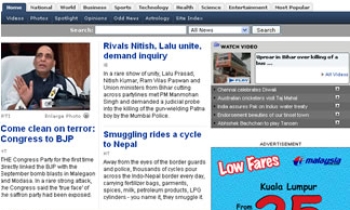Most executives in the beleagured newspaper industry tend to believe they have a product problem and not an image problem, and attempt to address it accordingly. Newspapers are pouring billions of dollars, euros, and yen into addressing the tangible with little to no results to show for it, according to a new report titled "Newspaper Outlook 2006: Managing Perceptions." What newspapers are not doing is addressing the intangible: perceptions, feelings, emotions.
The "Newspaper Outlook 2006" report represents the fifth annual strategic examination of the newspaper industry by the International Newspaper Marketing Association (INMA). INMA is a non-profit association dedicated to promoting advanced marketing principles within the newspaper industry, and is based in Dallas, Texas, US.
The report has been authjored by Earl J Wilkinson, executive director of INMA. Wilkinson, who authored four previous "Newspaper Outlook" reports for the newspaper industry in 2001, 2002, 2003, and 2004, also writes a monthly column at INMA.org on trends and developments in newspaper publishing. Newspaper Outlook 2006 articulates where newspapers are today, and where they are likely to go in 2006-2010.

The report points out that through much of the past century, the newspaper's sales, production, and editorial cultures have attempted to keep up with consumer feedback through literal means such as photographs, colour, design, format, zoning, story selection, free newspapers, "lite" newspapers, and popular newspapers. Yet the metrics continue to decline.
The ready availability of information during the past decade has nudged newspapers from a "needs-based" product to a "wants-based" product, observes Wilkinson. Many newspaper executives – from editorial to advertising to circulation to marketing – still believe they are in the "needs" business like water and utilities. The INMA executive director believes the market is clamouring for reasons to "want" newspapers for emotional reasons more associated with soda and other packaged-goods products. "Needs" are positioned and marketed very differently than "wants."
The INMA report advocates a sharp departure from the product management ethos that pervades today's newspaper business, and stresses on perception management. This may be because newspapers, by and large, have conducted research on what the market "wants", but not much research on how the market "perceives" newspapers.
Wilkinson notes that newspapers represent a bundle of perceptions. Some are true perceptions, and some are false. Newspapers can easily identify their own unique market perceptions. They can attempt to change perceptions, though this requires patience. False negative perceptions can be addressed through marketing and public relations, while true negative perceptions can be addressed through tangible changes in product and strategy.
Companies, argues the report, can "suggest" a perception or a position via traditional marketing methods. But if people use the product and become "vested" in the product over time, their emotional response takes precedence over the marketing message. If the emotional reaction is different than the positioning, then people will reject this positioning. Even worse, if the emotional response is in direct conflict with the marketing message, people will perceive the company as to be lying to them.
The INMA report points out the difference between emotional marketing which tends to draw consumers in, and rational marketing which tends to chase consumers. It goes on to suggest that newspapers should delve deeper into the emotional perception issues and alignment with readers. At minimum, perception should be a consideration in everyday management. At maximum, it should be central to a brand management approach of operating newspapers.
[To purchase the report, please visit the INMA website.]









